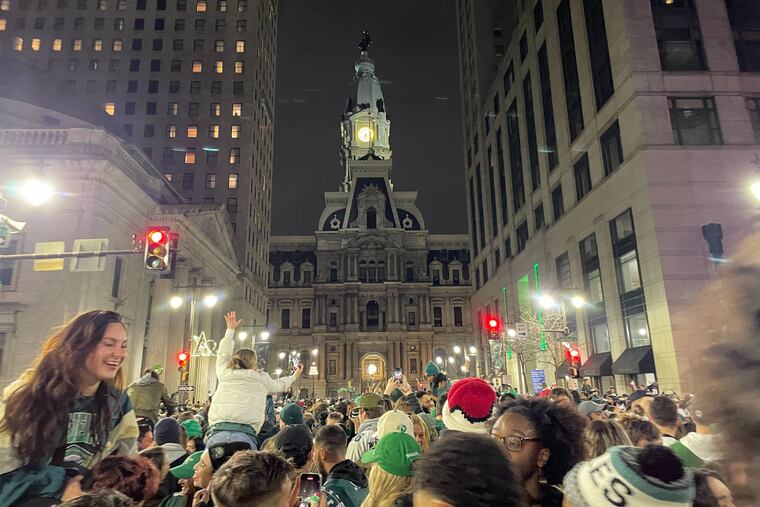Will a revitalized ‘cleaner, greener, safer’ South Broad Street rescue the arts?
Street activity begets street activity. The more people there are on the streets, the safer they feel, and the safer they feel, the more likely they are to come back.

As you walk from City Hall down South Broad Street, the character of the city gradually transforms. It goes from staid and august into being a kind of playground — as Christopher Morley noted a century ago.
“Broad and Chestnut is a phrase of great sanctity,” wrote the essayist and loving chronicler of all things Philadelphia in the Evening Public Ledger. But when Broad Street moves beyond the “office mountains” of banks and institutions at Chestnut, Walnut, and Locust, the city “kicks up its heels,” Morley wrote.
“Perhaps it is because William Penn on the City Hall is looking the other way that South Broad street feels it can cut up without reserve.”
The modern revitalization of South Broad Street in the 1990s was predicated on the idea of Philadelphia kicking up its heels, with hundreds of millions of dollars in new theaters and concert halls tied up in a bow: a cohesive new streetscape.
But the Avenue of the Arts concept is entering its fourth decade and that streetscape is in need of a refresh. The checkerboard pavers, planters, and retro light poles installed from City Hall to just below Washington Avenue were products of their time, and now the nonprofit group that shares in overseeing the boulevard’s welfare has begun to consider the next generation of street furniture and other improvements.
The light poles and pavers are staying, but it’s time to look at what will draw people today, says Avenue of the Arts Inc. executive director Laura Burkhardt, “and that is a cleaner, greener, safer Avenue.”
The benefits of Broad Street ripple out well beyond Center City. Even if development over the past decade or two has yielded new loci of activity — Fishtown, North Broad, Passyunk Avenue, the east end of Spring Garden Street — it’s still true that Broad Street from City Hall to about Pine is Philadelphia’s front door. For many visitors, whether they’re in town from London or Langhorne, this is the stretch that defines the image of the city.
It functions as our town square. When the city’s sports teams are winning big, it’s South Broad Street where tens of thousands gather. (Cue the cutting up without reserve.)
And yet since the pandemic, South Broad is showing signs of strain. Retail has largely left — a consequence of e-commerce as much as anything Philadelphia-specific, but troubling nonetheless. The street can be chaotic. Patrons leaving the theater are sometimes hit with the buzz-saw sounds of ATVs going up and down Broad Street (and elsewhere).
Some days it feels lonely. The number of visitors to South Broad from City Hall to Pine Street plunged with the pandemic. So far in 2023, the area has received an average of 10,304 daily visitors, or about half of the 18,395 who passed through the area each day in 2019, according to data accessed by the Center City District from Placer.ai.
Sitting on the cusp of the pandemic — as we are now — is instructive. 18,395 felt like critical mass; 10,304, not quite.
No one knows exactly why arts and culture attendance is down since the pandemic shutdown lifted (though there’s plenty of anecdotal evidence), but a second revitalization of South Broad Street is a well-timed weapon against two of the factors that seem to be keeping some home: apathy and fear.
What will change?
To help with making Broad Street safer and greener, Avenue of the Arts Inc. has engaged Gensler (the architecture and design firm working on the proposed 76ers arena project on Market Street) and landscape and urban planning firm OJB to come up with concepts.
Planners are several months from having a blueprint for the next generation of streetscape improvements. But ideas are likely to include landscaping, signage, outdoor dining, and bringing art out onto the street, as well as new crosswalks and other changes to help reduce the power differential between pedestrian and vehicular traffic.
Avenue of the Arts Inc. might not have the resources to re-ignite South Broad on the scale of the initial investment in the early 1990s, which included federal, state, and city funds. These new changes will be more modest and may have to roll out over several years as funding becomes available.
But that doesn’t mean that a smart, ambitious project can’t be a powerful catalyst.
It’s important to recognize the chicken-and-egg factor at play: Street activity begets street activity. The more people there are on the streets, the safer they feel, and the safer they feel, the more likely they are to come back. Some of Center City’s problem is perception and some of it, reality. That doesn’t mean, however, the two don’t dance with each other.
Safety is important. And so are other feelings — the awe you feel walking into the Kimmel plaza on a dazzlingly sky-blue day, or the cozy respite of a beer garden.
One of the most intriguing post-pandemic attendance trends is the one suggesting that people will still show up in big numbers for performances and other events they perceive as somehow special or singular.
Art can’t always meet such market-driven expectations, nor should it. But creating the right streetscape for our times would be a good first step in reversing a cycle that, if not thwarted soon, could become a vicious one.